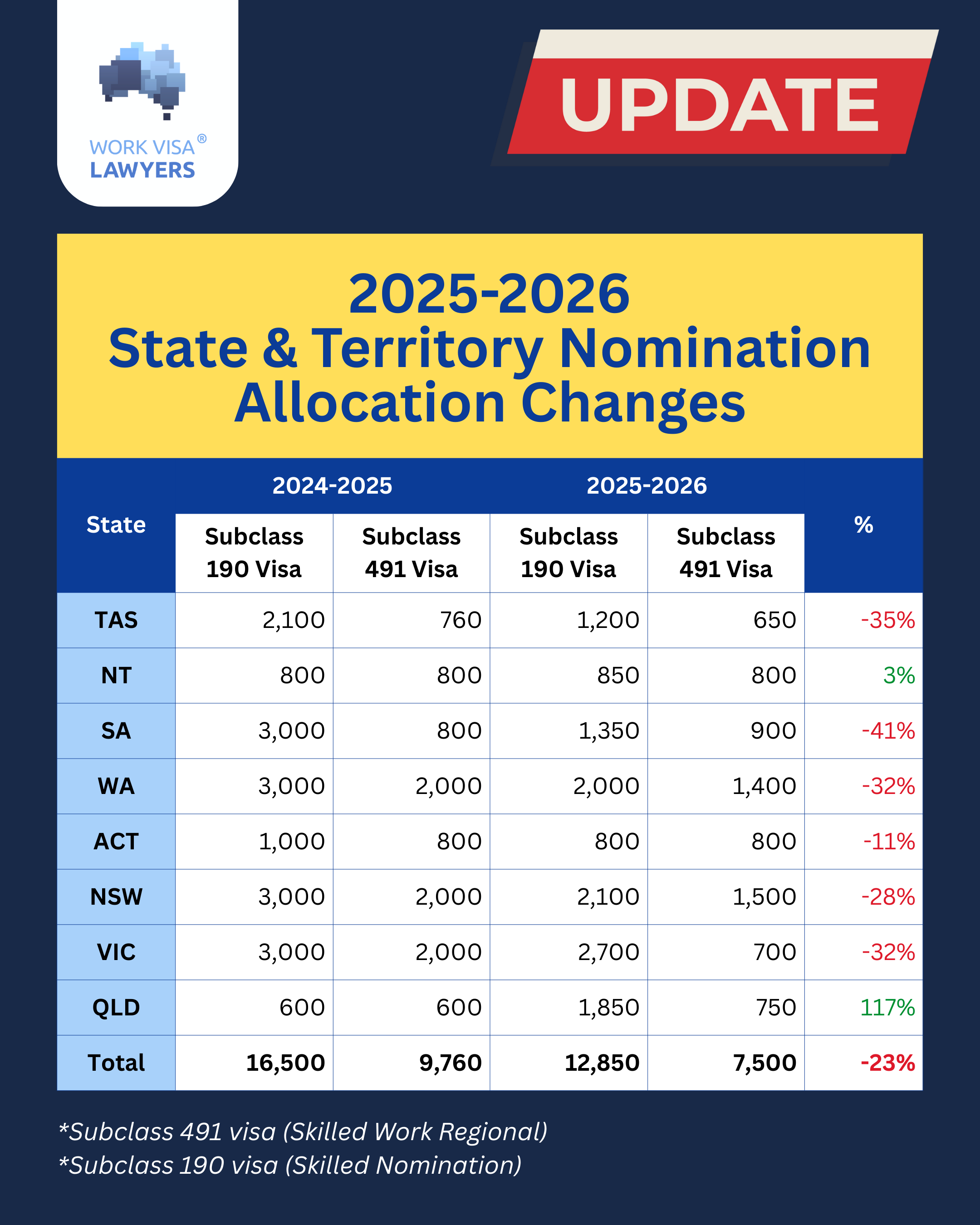South Australia Opens 190 and 491 Visa Programs for 2025–26
South Australia (SA) has officially opened applications for the Skilled Nominated (subclass 190) and Skilled Work Regional (subclass 491) visas and released its updated criteria on the Move to SA website.
For the 2025–26 program, including interim allocations, South Australia has received:
| SA State Allocation 2025-26 | |
|---|---|
| Visa | Places |
| 190 Visa | 1,350 |
| 491 Visa | 900 |
This year brings one of the biggest changes in recent years:
- SA has removed 71 onshore occupations from the skilled list
- Reducing the number of eligible onshore occupations from 464 last year to just 393 this year
- There are 278 offshore occupations available
Combined with significant allocation cuts, the 2025–26 program will be far more competitive than previous years.
With a 41% overall cut, South Australia now faces the largest reduction in nomination places across the country.
If you work in construction, health, teaching or have a high salary, you may have a better chance of being invited by SA.
South Australia Skilled Migration Streams
South Australia continues to operate four key nomination streams:
- South Australian Graduates
- Skilled Employment in South Australia
- Outer Regional Skilled Employment
- Offshore
The eligibility and competitiveness within each stream have shifted significantly, and it will be more difficult to receive a nomination.
Onshore Applicants: ROI Required
Onshore applicants must now submit a Registration of Interest (ROI).
SA will consider a mix of factors from your ROI when deciding whether to invite you for nomination.
Key assessment factors include:
- English language level
- Years of skilled experience
- Skills and qualification level
- Salary level
- Employer assessment (for those employed in SA)
Tip: For onshore applicants, points do not matter.
Minimum Work Requirement – SA Onshore Applicants
All onshore applicants must be working at least 30 hours per week for a set period based on their stream.
This means most international students will not be eligible, as student visa work rights limit them to 24 hours per week or 48 hours per fortnight.
Occupations – 491 Visa Only (Not Eligible for 190)
A significant number of occupations have shifted to the 491 visa only, reducing access to the 190 visa pathway.
Examples include:
- Accountant
- Dentist
- Motor Mechanic
- Marketing Specialist
Occupations No Longer Eligible for the SA Graduate Stream
- Chefs
- Cooks
- Cafe or Restaurant Managers
- Enrolled Nurses
Occupations Keeping 190 or 491 Options
Despite the major reductions, some high-priority occupations still retain 190 eligibility, including:
- Engineers
- Teachers
- Registered Nurses
These align with South Australia’s priority industry needs.
South Australia Priority Sectors for 2025–26
The state will prioritise applicants in:
- Building and Construction
- Defence
- Education
- Engineering
- Health
- Manufacturing
Applicants in these sectors may remain competitive for 190 nominations, depending on experience, English level and employment arrangements.
Offshore Applicants: No ROI Required
Offshore applicants do not need to submit an ROI.
Invitations will be issued directly from SkillSelect based on your EOI.
For offshore candidates, the primary assessment factors remain:
- Your occupation
- Points score
- Competitiveness within your occupation group
Not all occupations have offshore pathways. Some are onshore-only, and others are 491 only.
Tip: Points matter for offshore applicants.
Numbers and Competition
Last year (2024–25), South Australia had about 60,000 EOIs and ROIs for only 3,800 places. This means the chance of getting an invite was very low — about 6.33%.
This year (2025–26), if there are still around 60,000 applications but only 2,250 places, the chance of getting invited will be even lower — around 3.75%.
Tip: If you are not receiving an invitation, consider other visa options such as employer-sponsored visas (482 visa, 186 visa, 494 visa or DAMA) or a partner visa if you have an Australian partner.
What These Changes Mean for Applicants
- Expect fewer invitations overall
- Many occupations will now only access the 491 visa
- SA employment is becoming a key factor
- Offshore candidates will likely need high points to stay competitive
- Some occupations require SA employment even for Graduate pathways
- Employer sponsorship pathways (482 → 186) may be more reliable
If you intend to apply through South Australia, early planning and strategy are more important than ever.
You can book an appointment with one of our migration agents or immigration lawyers.










